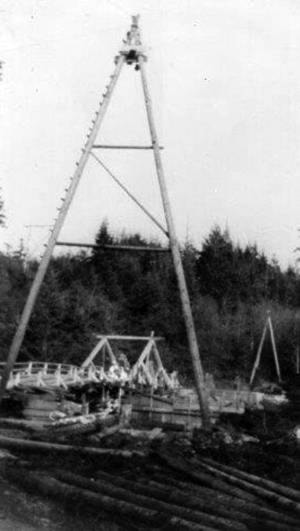Elida Peers | Contributed
This photo, showing construction of a new bridge over Muir Creek in 1924, came from Victoria Clay, a daughter of the Donaldson family that arrived in East Sooke early in the 1900s.
When a new bridge built over the Sooke River in 1921, she met and married bridge worker William Clay, and one assumes that she took this photo when he later worked on the Muir Creek bridge.
In earlier days the creek would have been traversed via logs, and of course with First Nations’ travel, canoes would have stopped at the eastern point and camped while the paddlers were en route to northern climes.
The eastern side of the estuary was a picnic site during the 1920s and 1930s, when Shirley began developing a social community.
ALSO READ: The history of Muir Creek School
Nowadays we whiz over the modern concrete and steel structure without a second thought, but it was not always so.
There was a substantial bridge, though, on the gravel road that connected Sooke to Jordan River when Elder Logging was the main employer of the area from the mid-1930s through the 1940s and 1950s.
The name Muir Creek comes from the distinguished pioneering family of John and Ann Muir, who took up Sections I, II, and III in 1851. Their four sons were Andrew, Robert, John and Michael.
While Andrew became sheriff of Victoria, the three younger sons became part of the pioneering logging, shipbuilding and farming enterprise that was initiated at what is known as Woodside Farm on today’s West Coast Road.
Long ago, December 31, 1900, crossing Muir Creek precipitated a tragedy.
The Muir family had a barn up the hill on the west side of the creek where they housed oxen for logging the tall timbers in the watershed. Two grandsons of the original John and Ann Muir Sr., John and Andrew, left Woodside with a team and a wagonload of hay, intended to supply the oxen.
When they reached the creek, which had two logs felled across the expanse to facilitate crossing, no one knows for sure what happened, but something spooked the horses, and they took off.
Sadly, when the boys’ father, John Muir Jr., and his youngest son, Douglas, went out with lanterns that evening looking for them, both young men were found in the creek with necks broken.
The two are buried together in the Muir cemetery on Maple Avenue.
•••
Elida Peers is the historian of the Sooke Region Museum.
